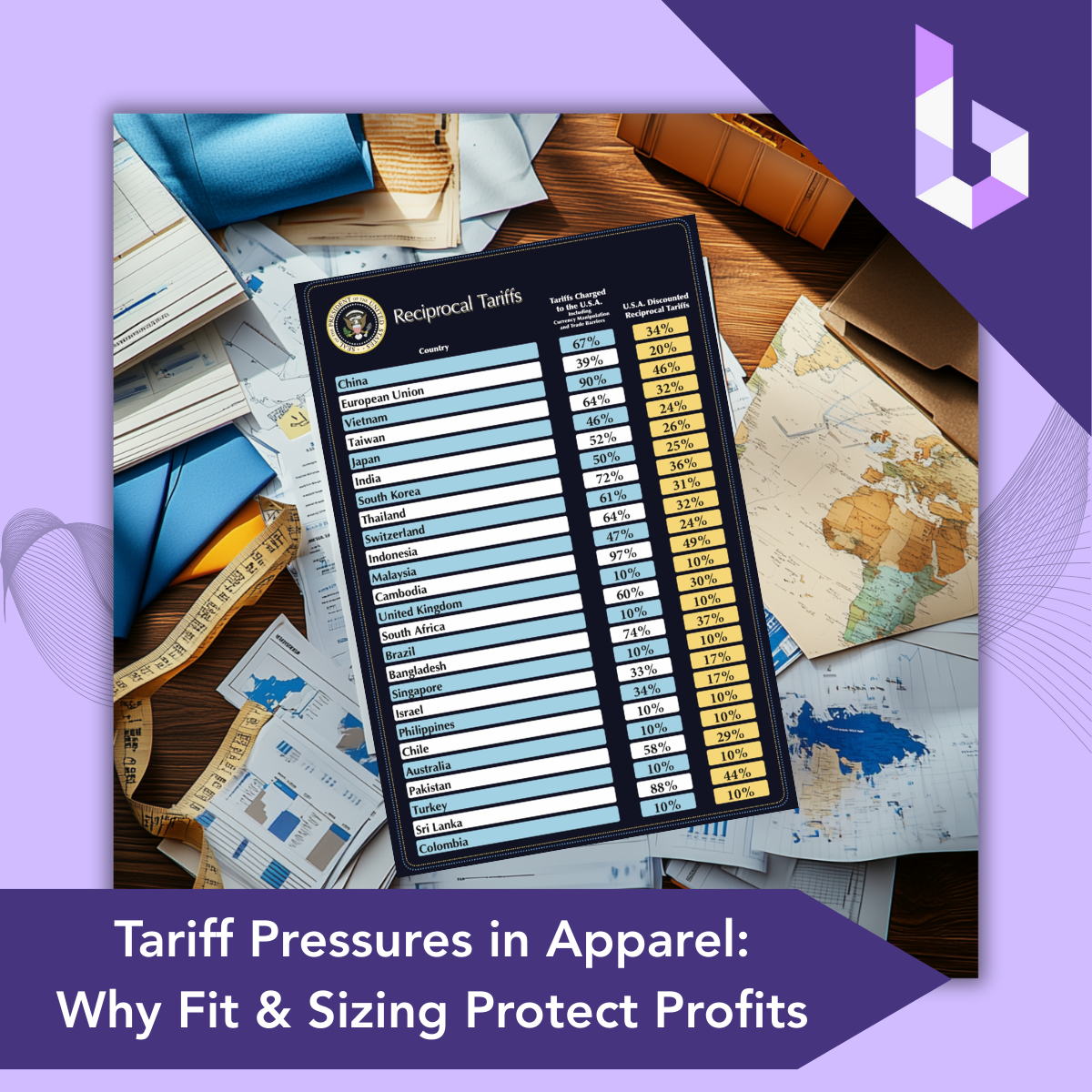
Tariff Pressures in Apparel: Why Fit & Sizing Protect Profits
July 2025 Update: Renewed Tariff Volatility Brings Fresh Risks for Fashion
The Trump administration’s tariff strategy has once again shifted, injecting new uncertainty into global apparel sourcing. On July 8, a last-minute executive order delayed the implementation of new tariffs—originally scheduled for July 10—until August 1, 2025. While the delay offers brands a narrow window to adjust holiday inventory plans, the broader outlook remains volatile.
Key developments include:
-
New country-specific tariff rates: 25% on Japan and South Korea, 30–40% on Indonesia, Thailand, and Bangladesh, and up to 50% on Brazil. Vietnam, despite a deal, still faces a 20% duty.
-
Tariff threats against BRICS countries (Brazil, Russia, India, China, South Africa) and any perceived “Anti-American alignment,” adding to global trade anxiety.
-
A temporary pause on China’s 145% tariff expires in August, keeping major sourcing decisions in limbo.
For fashion brands, the impact is immediate and multi-layered. Some, like Nike and Gap, have already forecast tens of millions in profit losses, with Nike warning of a $1 billion hit if current tariffs hold. Others, including Abercrombie & Fitch, PVH, and H&M, are strategically absorbing costs to gain market share—while rivals like Shein, Lululemon, and Ralph Lauren are moving forward with price increases on select product lines.
Beyond pricing, production is also under strain. Walmart has paused major apparel orders out of Bangladesh, while Levi’s is streamlining its holiday assortment to mitigate tariff exposure. Even brands that have invested in diversification are finding limited relief: tariffs on countries like Vietnam and Bangladesh have made “safe” alternatives suddenly more expensive.
The common thread? Fashion brands are navigating a rapidly changing cost landscape—with little clarity. As Aneesha Sherman of Bernstein notes, “Companies can’t make decisions on investment or supply chain shifts with the rates constantly changing.”
Now more than ever, protecting gross margins requires more than just shifting sourcing. Brands must double down on high-efficiency levers like AI-driven sizing solutions to reduce returns, optimize inventory, and preserve profitability in a highly unstable trade environment.
TL;DR — July 2025 Tariff Curveball
| What happened? | Why it matters |
|---|---|
| Delay until August 1 | Provides short-term leverage—but delivery timing must be managed |
| Tariff hikes on ASEAN, Vietnam, Brazil | Expands risk beyond China |
| Industry price hikes are selective | Brands choose which goods to pass on |
| Sourcing stress continues | Diversification is necessary but costly |
| Margin erosion is real (1–4 pts) | AI sizing and reduced returns can buffer impact |
The apparel landscape is undergoing seismic shifts as new tariffs send ripples through an industry already grappling with economic headwinds. With increased costs on products manufactured outside the United States, apparel brands are now facing a triple-edged challenge: how to manage rising production fees without alienating consumers or compromising quality. This isn’t just another market hiccup—it’s a call for bold, innovative solutions.
U.S. apparel brands rely on global manufacturing to deliver affordable, high-quality products at scale. But new tariffs are going to hit the industry’s biggest suppliers hard — Vietnam (46%), Cambodia (49%), Bangladesh (37%), China (now up to 104%), and even the EU (20%) at the time of this writing. Despite the 90-day pause (with the exception of China), staying ahead of these changes is no easy task, as rates and exclusions are constantly in flux.
Tariffs present a serious cost spike for brands sourcing overseas. Major retailers rely heavily on these regions for production, with some sourcing over half of their products from just Vietnam, Bangladesh, and Indonesia. The U.S. Fashion Industry Association warns these tariffs will “bring an unfair burden to American families,” especially lower-income households. Bottom line: American fashion runs on global supply chains, and these tariffs threaten to unravel that foundation. (BBC)
The Rising Cost Dilemma
Tariffs have added a hefty layer of expense to the production process. Traditionally, apparel brands relied on global supply chains to offer competitive pricing and variety. However, the new tariffs impose additional fees on imported goods, meaning brands must either pass these costs onto consumers or absorb them internally. For many brands, especially during a period of already steep inflation, raising prices could spell disaster. Consumers, squeezed by the rising cost of living, are less likely to welcome further price hikes.
Tough Choices: Pricing vs. Operational Cuts
- Efficiency Under Pressure:
Fashion supply chains are under “incredible duress” in 2025 (McKinsey), with 39% of execs expecting conditions to worsen. While some brands—like Steve Madden—are cutting Chinese imports by up to 45% to offset tariffs, that shift comes with a cost: longer lead times, higher nearshoring expenses, and more complex logistics. U.S. manufacturing investments are rising (up 20 points in five years), and China’s share of U.S. apparel imports has dropped by six points since 2019. But with most brands still in “wait-and-see” mode, the industry faces a tough balance between reducing tariff exposure and maintaining fast, efficient supply chains. In short, avoiding tariffs often means trading efficiency for resilience—longer shipping routes get swapped for shorter ones, but at a higher cost, and well-oiled sourcing networks are replaced by new, less-optimized ones. - Sustainability Trade-Offs:Others might reduce their commitment to sustainable practices, trading quality and ethical production for short-term cost savings. As Kenneth P. Pucker notes in The Business of Fashion, the escalating trade war is likely to "eviscerate efforts to transform the industry for the better," as economic hardships prompt brands to prioritize immediate financial concerns over long-term sustainability goals. The increased costs associated with tariffs can lead brands to cut back on investments in sustainable materials and ethical labor practices, undermining progress made in recent years.
- Workforce Reductions: Sourcing Journal's industry analysis documented over 18,500 fashion and retail jobs at risk in January 2025 alone—more than triple the 4,686 jobs cut in the second half of 2023—with significant cuts at household names as an attempt to preserve margins amid mounting cost pressures.
- Excluding Inclusive Sizing: Over the past few years, inclusive sizing has gained momentum as brands expanded their offerings to include petite, tall, and plus sizes. This strategy helped them better serve both existing customers and previously overlooked market segments. But today's tariff environment complicates these initiatives—additional SKUs mean more inventory investment, higher import costs, and greater financial risk. Brands are now forced to recalculate which size extensions actually deliver profitable growth.
Each of these paths carries its risks and can ultimately harm a brand’s reputation and consumer trust. As Vogue Business discussed in-depth, the struggle isn’t just about balancing budgets—it’s about preserving the integrity and future viability of the brand.
The Strategic Value of Fit in a Tariff-Driven Economy
When costs go up, brands are presented with a new reality where margins shrink, operational inefficiencies are magnified, and extra costs are passed on to the consumer. In this new reality, every return hits harder. With tariffs increasing the cost of production and imports, and customer acquisition costs already sky-high, brands can’t afford the 30–50% return rates that have become a norm in apparel eCommerce. Most of those returns come down to one issue: fit.
In this climate, a fit and sizing strategy is no longer a “nice to have”, back-of-house concern or a post-purchase fix. In a tariff-driven economy, fit and sizing is a frontline strategy that can mean financial survival. Here’s why:
- Return Reduction = Margin Protection: The most immediate value of accurate fit is fewer returns. Every return avoided under these tariffs translates into retained revenue and avoided logistics costs—a meaningful difference in a world where each percentage point counts.
- Smarter Inventory Planning: AI-powered fit data improves recommendations and feeds back into demand forecasting. Brands can use body data insights to optimize size curves, reducing overproduction of unpopular SKUs, minimizing deadstock, and supporting leaner, more resilient supply chains.
- Lower Risk on Size Extensions: Expanding into petite, tall, or plus sizes is financially riskier under tariffs. But with AI-driven sizing solutions, brands can predict sizing needs more accurately and personalize offerings without ballooning inventory costs, keeping inclusivity viable.
- DTC Conversion and Lifetime Value: A better fit experience increases conversion and loyalty. When shoppers find the best fit the first time, they’re more likely to buy again, and less likely to defect to a competitor. In a cost-squeezed environment, that lifetime value lift is a huge win to preserve.
- Sustainability Without Sacrifice: Returns aren’t just expensive—they’re wasteful. By reducing fit-related returns, brands can protect their sustainability goals without sacrificing materials, labor, or ethics.
The new tariffs are undeniably challenging, but they also present an opportunity for brands to revamp their fit strategies. Brands using AI sizing solutions that build on customer body data are better positioned to reduce size-related returns while boosting client satisfaction and minimizing the margin loss from tariff-inflated goods.
In this rapidly evolving landscape, the future belongs to those who adapt and dare to innovate. For apparel brands facing unprecedented challenges, the choice is clear: transform adversity into opportunity with bold, data-driven strategies that safeguard profit margins without compromising on quality or consumer trust.
Tariffs don’t just reshape costs—they reshape priorities. Fit isn’t just a feature—it’s a strategic foundation for brands that want to stay profitable, inclusive, and resilient in a volatile global market.
Curious about what you should be looking for when evaluating tech vendors? Learn More About the 5 Questions to Ask When Evaluating Fit Tech Vendors


.png?width=600&height=408&name=march%202023%20-%20french%20toast%20(1).png)

.png?width=1080&height=1080&name=Bold%20Metrics%E2%80%99%20digital%20twin%20technology%20helps%20some%20of%20the%20worlds%20biggest%20bands%20increase%20conversion%20and%20AOV%2c%20reduce%20returns%2c%20optimize%20their%20customer%20experience%2c%20and%20boost%20brand%20loyalty.%20(2).png)








